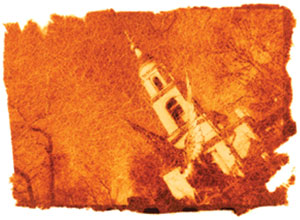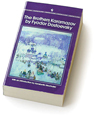A Mighty Symphony of Ideas
Full of Passion, Intrigue and Faith, The Brothers Karamazov
Explores the Most Powerful of Human Questions
 |
 |
| |
The Brothers Karamazov by Fyodor Dostoevsky
is a life-changing book — as many Seattle Pacific University students
can tell you — and not just for the bragging rights that come with
reading a long, dense, 19th-century Russian novel. Rather, The Brothers
Karamazov changes lives because it invites readers to enter into
a world overflowing with many of life’s most fundamental questions.
How do we have faith in a world that values money, power and “scientific
reasoning” most of all? What does human love look like, either in
families or in potential mates? How do we confront the reality of
evil in our world?
All of these questions and more are at the heart of a novel that
has been considered a masterpiece almost since the time of its original
publication in 1880. For SPU’s University Scholars, The Brothers
Karamazov is one of the centerpieces of “Texts and Contexts III,”
a course that examines the emerging Modern Period, beginning with
the 17th-century Scientific Revolution and ending with the writers
and thinkers of the early 20th century.
In this class, as in all of the University Scholars courses, we
investigate the texts we read through the lens of four fundamental
themes: the problem of evil, the problem of violence, the problem
of faith and reason, and the problem of the individual and society.
This provides a useful framework to explore the ideas of the modern
world as the students read works from Bacon and Descartes to Marx
and Freud.
Unlike some of the other texts of modernity, however, The Brothers
Karamazov is deeply engaged with all four of these investigatory
themes, not just two or three of them. In fact, The Brothers Karamazov
is arguably the magnum opus of not just Texts and Contexts III but
of the entire University Scholars Curriculum. Each of these themes
— evil, violence, faith and reason, the individual and society —
contributes to a mighty and interwoven symphony of ideas.
Indeed, Dostoevsky’s masterpiece shows how inextricable these
themes are from each other. Can we separate the problem of evil
from the problem of violence? Doesn’t the relationship between faith
and reason dramatically shape an individual’s understanding of society
and his or her place in it? The connections resonate throughout
the novel.
“A Nice Little Family”
Yet, above all, this book is a story. Themes and ideas take root
only in the context of a gripping and interesting tale. And The
Brothers Karamazov has plenty to keep even the most reluctant reader
turning pages — everything from affairs of passion, intrigue and
murder to the most moving scenes of tenderness, love and faith.
The novel centers around one particular family. There is a crude
and wealthy father, Fyodor Pavlovich Karamazov, whose selfishness
and vulgarity is nearly matched by his overwhelming greed. This
father Fyodor has three sons, Dmitri, Ivan and Alexei, whose lives
we follow with interest as they enter young manhood and face some
of life’s most important and difficult choices, such as what vocation
to follow, who to love and marry, what ideals to believe in. In
addition, we soon come to suspect that there is a fourth, though
illegitimate, Karamazov son: the character called Smerdyakov, who
lives and works as a servant. It’s not hard to imagine the many
tensions arising from such a “nice little family,” as it is ironically
called in the opening section of the book.
The three — or perhaps four — sons we come to know as the “brothers
Karamazov” are as different as real-life brothers often are, shaped
by the particularities of birth order, family circumstances, education,
life experiences and friendships. Dmitri, the eldest, is a military
officer prone to passionate outbursts of love and hate, whose good
heart is sometimes betrayed by both his thoughtlessness and recklessness.
Ivan, the next brother, is the cool, dispassionate intellectual
who longs to be more “rational” and “European.”
The third Karamazov son is the ostensible hero of the tale, as the
narrator informs us from the very first pages of the novel. Alexei,
or “Alyosha” as he is often fondly called, is a gentle and faithful
young man, training to be a monk and seeking to follow God throughout
the turbulent events of the novel. Alyosha is often the magnet for
other characters to confront their own evils or through whom a Christlike
redemption and healing is begun. Yet Alyosha is not an unrealistic
character, either. We see him struggle with the choices in his own
life, as the son and brother of all the Karamazovs.
The Narrator, “The Grand
Inquisitor” and Father Zosima
Not surprisingly in such a long novel, there is a lot to keep track
of as readers follow the unfolding events. We are guided through
these events by another character called “the author,” who is not
to be confused with Dostoevsky himself. This narrative technique
of “speaking directly to the camera,” as it were — making the narrator
a character — is one of Dostoevsky’s greatest gifts as a novelist.
“The author” tells us he is simply “remembering” the events that
happened in his town a few years ago and so underlines the realism
that is both a hallmark of 19th-century novels and a tool to maximize
the effect of the story upon readers. It is, after all, something
that “really happened,” testifies the narrator.
The narrator character also allows Dostoevsky the novelist the freedom
to comment on events and “the state of Russia today” while not speaking
either for himself directly or in the godlike pose of an omniscient
narrator. The narrator has the freedom to be wrong in the same way
a real-life eyewitness would be likely to misunderstand or forget,
and in so doing to introduce comedy and confusion — for example,
when he reports on speeches and testimony in a courtroom and says
that he’s “probably not saying it all correctly.”
Two other important features of The Brothers Karamazov must be mentioned
in an introduction to the novel: first, the famous subsection titled
“The Grand Inquisitor,” which has sometimes been published separately
as a short story; and, second, the crucial character of Father Zosima,
Alexei’s spiritual mentor at the monastery.
“The Grand Inquisitor” is actually a story that Ivan Karamazov has
written as his counter to biblical narratives that explain God’s
purposes on earth and his relationship to human beings. Without
giving too much away, “The Grand Inquisitor” is in itself a masterpiece
of psychological literature with a chilling effect on its readers
and listeners.
The character of Father Zosima, on the other hand, is a model of
love, faith and wisdom. During the first half of the novel, when
Alexei is living at the monastery and being closely discipled by
the Father, we as readers are privileged to follow along in his
teachings, learning as Alexei does about how God brought Father
Zosima to this depth of faith and understanding. We, like Alexei,
become equipped with the Father’s words: “But on earth we are indeed
wandering, as it were, and did we not have the precious image of
Christ before us, we would perish and be altogether lost, like the
race of men before the flood.”
Father Zosima and Alexei come to model that “secret, mysterious
sense of our living bond with the … higher heavenly world” — and
we are going to need it as our own broken and dangerous world comes
crashing into the lives of the Karamazovs.
Reading the Novel
As I often tell SPU students who are encountering the novel for
the first time, a person has to be thoughtful and intentional when
reading this nearly 800-page book, translated from the Russian and
written more than 100 years ago. This won’t be a quick read, naturally,
and it won’t have the quick pacing and rapid plot events that contemporary
novels and films do. In fact, before we read, we need to think for
a minute about what we’ve been conditioned to expect from a novel
and then take a deep breath and slow down, changing those unconscious
expectations.
It is also important to be aware of the difficulties that arise
when readers encounter the differences in cultural behavior and
attitudes, and in the Russian Orthodox faith tradition, in The Brothers
Karamazov. It might be useful to think of the reading process as
one of gradually understanding this different world through a long
immersion in its thinking and practices. It takes time to be able
to live in this novel’s world, but it is time immensely worth the
taking.
Finally, then, read this amazing book as the University Scholars
do, asking the questions: “How does it engage the problem of evil,
the problem of violence, the problem of faith and reason, and the
problem of the individual and society?” Consider each of the characters
and events and think through how you’d answer those questions. Then
ask yourself — or someone else who can share in the reading and
discussion of this novel — “How has your life been changed by reading
Dostoevsky’s The Brothers Karamazov?” I hope that the answer is
a profound one.
BY CHRISTINE CHANEY, ASSISTANT PROFESSOR OF ENGLISH
Back to the top
Back to Home |
 |

Click on image to enlarge.


|
 |





